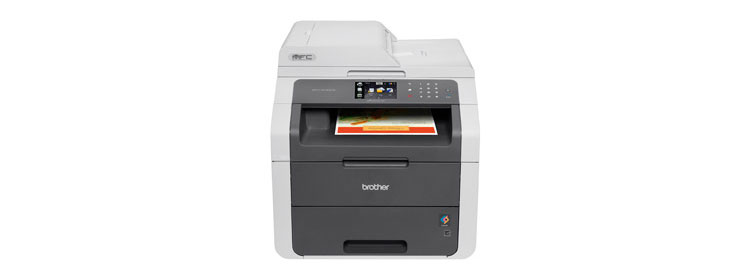BY TONY HOFFMAN
The Brother MFC-9130CW$349.99 at OfficeMax is the junior of three LED-based multifunction printers (MFPs) that the company recently introduced , offering a sparser feature set than the Brother MFC-9330CDW$349.99 at OfficeMax orBrother MFC-9340CDW at a slightly lower price. If duplex (two-sided) printing, copying, scanning, or faxing—or printing directly from a USB key—isn’t important to your small or home office, it can save you some money over the other two MFPs.
The MFC-9130CW can print, copy, scan, and fax. It lets you fax either from your computer (PC Fax), or as a standalone unit without needing a computer. a USB thumb drive. It includes a 35-page automatic document feeder (ADF) for unattended copying, scanning, or faxing of multi-page documents of up to legal size. Unlike the MFC-9340CDW, it doesn’t support duplex scanning, copying, or faxing; although you can still scan two-sided documents, you’d have to feed it side by side, a page at a time.
The Brother MFC-9130CW is two-toned (off-white and gray) MFP is boxy except for a swept-back front panel, which includes a 3.7-inch color touch screen. The backlit numerical keypad to the right of the touch screen only appears when you press Fax or other functions that require data entry. The only physical button visible is the Start/Stop button.
The MFC-9130CW uses LEDs in place of lasers as a light source. LED printers are generally smaller than the equivalent laser printers, and this model is no exception: It’s reasonably compact at 16.1 by 16.1 by 19 inches (HWD) and weighing 49.6 pounds.
Paper capacity is 250 sheets, plus a one-page manual feed slot. Unlike the Brother MFC-9330CDW and Brother MFC-9340CDW, it lacks an automatic duplexer for printing on both sides of a sheet of paper. The driver provides on-screen guidance for manual duplexing.
The MFC-9130CW connects to a PC via a USB cable, or to a network via Ethernet or WiFi. It supports Wi-Fi direct, which allows for direct printing between compatible devices without the need to go through a WiFi network. It’s compatible with Apple AirPrint, Brother iPrint&Scan, Google Cloud Print, and Cortado WorkPlace for printing from mobile devices. I tested it over an Ethernet connection, with the drivers installed on a computer running Windows Vista.
Printing Speed
I timed the Brother MFC-9130CW, rated at 19 pages per minute for both color and monochrome printing, on our business applications suite (as timed with QualityLogic‘s hardware and software) at 6.5 effective pages per minute (ppm), a decent speed for its price and rated speed. It was a little faster even than the Brother MFC-9340CDW, rated at 23 ppm, which tested at 5.8 ppm, and just slower than the Brother MFC-9330CDW, rated at 23 ppm, which I timed at 6.8 ppm. The Editors’ Choice Dell 2155cn $439.99 at Dell, rated at 24 ppm for both color and monochrome, was a touch slower, at an effective 5.9 ppm. The Ricoh Aficio SP C240SF$410.26 at pcRUSH.com, though rated at only 16 pages per minute for both color and mono, nearly matched the MFC-9130CW, at an effective 6.3 ppm.
Output Quality
Overall output quality for the MFC-9130CW was a touch below par. Text quality was right on par for laser-class printer, which is to say very good. It’s fine for any business use short of ones that require very small fonts, such as demanding desktop publishing applications.
Graphics quality was par for a color laser. Colors were generally well saturated; some dark backgrounds looked a bit blotchy. There was mild banding (a regular pattern of faint striations) in many of the illustrations. It did not do well in showing a gradient between darker and lighter tones, as the printed output showed little difference between them. Graphics are fine for in-house business use, including PowerPoint handouts, though I’d be hesitant to pass them to clients I was seeking to impress.
Photo quality was below par for a laser. Prints were on the light side, with some colors muted. A monochrome photo showed a slight tint. Several prints showed mild banding. Posterization (an abrupt shift in color where it should be gradual) was evident in one photo that tends to bring it out. Quality is fine for printing out images from Web pages or files, but that’s about all.
The MFC-9130CW costs a bit less than the two other MFPs that Brother released at the same time, the MFC-9330CDW and MFC-9340CDW, and it has a more modest feature set. In particular, it lacks the ability to automatically print, scan, copy, or fax two-sided documents, and eschews a port for a USB thumb drive. Its output quality, though comparable to its two “brothers”, falls short of that of the Editors’ Choice Dell 2155cn.
In short, the Brother MFC-9130CW has decent speed for a small-office, laser-class MFP. Its relatively low price comes at the expense of some features like duplexing. Its text quality is fine for nearly any business use. Graphics and photo quality, though fine for most in-house use, are short of what we look for in a printer suitable for outputting basic marketing materials and the like. It’s a good, cost-effective MFP for an office with an occasional need for color printing, provided that high-quality color output isn’t paramount.
original article
- Brother MFC-9130CW (pcmag.com)








